AMD A10-6800K Review: Richland – Desktop APUs from 2013

AMD decided to refresh their Socket FM2 platform and release a new generation of hybrid processors for it based on Richland design. This is exactly the one that earned the “Elite Performance APU Platform” title in the mobile segment.
Intel’s recent release of the Haswell CPU family has provoked some sensation and AMD, which still wants to be viewed as a worthy competitor to Intel, doesn’t want to be left in the sidelines. Hoping to get its own minute of glory, AMD scheduled an announcement of its own to follow right behind the fourth-generation Core series. It is the announcement of hybrid processors for desktops known under the name of Richland. The Richland can hardly be as sensational as the Haswell, though. First of all, Richland-based APUs have already been available on the mobile market, so there is nothing particularly innovative about them. And secondly, the Richland represents almost the same CPU design as AMD used to promote under the Trinity brand.
Still, AMD wants us to believe that the product is new and fresh. To understand why that’s so important for the company, we must take into account that the Richland is not just a desktop APU design but part of AMD’s updated mobile solutions portfolio which includes Temash, Kabini and Richland series. The first two are truly innovative, featuring a completely new microarchitecture codenamed Jaguar. The Richland, on its part, was an addition to the model range which enabled AMD to offer mobile computer integrators high-performance CPUs besides energy-efficient ones. Considering that AMD isn’t very good at developing high-performance CPU microarchitectures, the Richland is yet another rebranding. The company wants to market its older solutions under a new name and does that quite successfully. The Richland and its cousins have managed to promote users’ interest towards AMD solutions in every segment of the mobile market. So now, besides tablets, transformers and inexpensive notebooks based on the Temash and Kabini, we’re expecting a large number of Richland-based gaming notebooks which are going to replace Trinity-based products of the previous generation.
Meanwhile, AMD is set to make the rebranding trick once again, but on the desktop market. Its APU concept, implemented in desktop PCs by means of Llano and later Trinity CPUs, needs to be upgraded from time to time, so the Socket FM2 CPU family represented by the A10, A8, A6 and A4 series is complemented with new products with model numbers in the 6000ths. The manufacturer touts this as the next step in the development of desktop APUs, putting an emphasis on the implementation of the Richland design.
We’ve managed to get a sample of the AMD A10-6800K, the senior model of the new generation, and we are going to test it and see why the desktop Richland CPUs have added 1000 to their model numbers compared to their Trinity counterparts.
Richland: What’s New?
It’s hard to tell much about the Richland design. Suffice it to say that it is the same Trinity but with slightly higher clock rates. According to AMD’s current plans, the Richland is a minor upgrade on the Trinity which should keep users entertained until the company has finished its truly innovative hybrid processors codenamed Kaveri. It is then that we will see a whole lot of new features: the Steamroller microarchitecture, GCN-class graphics, and support for heterogeneous computing with fully unified memory.
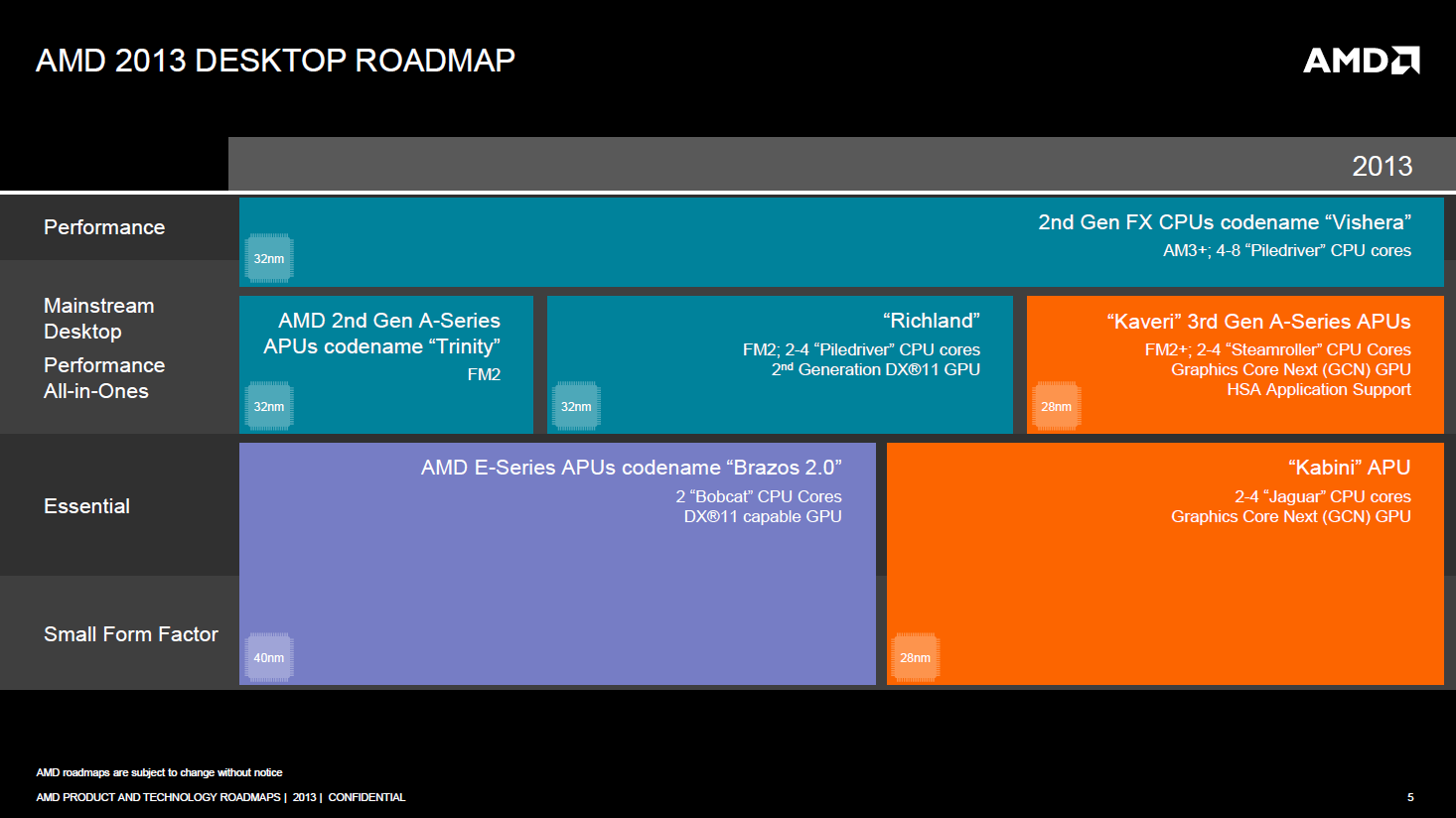
As for the Richland, it consists of the same constituents as the Trinity: Piledriver modules and a VLIW4 graphics core. The integrated graphics has been rebranded, too. AMD calls it Radeon HD 8000 but it is almost the same as in the Trinity where it used to belong to the Radeon HD 7000 class and has the same architecture as discrete graphics cards of the Radeon HD 6900 series.
Richland CPUs are manufactured on 32nm tech process, which is used for all other desktop CPUs from AMD, so their semiconductor die doesn’t differ from the Trinity die visually. It is 246 sq. mm large, incorporating about 1.3 billion transistors. About 42% of the transistor budget is allotted for the graphics core.
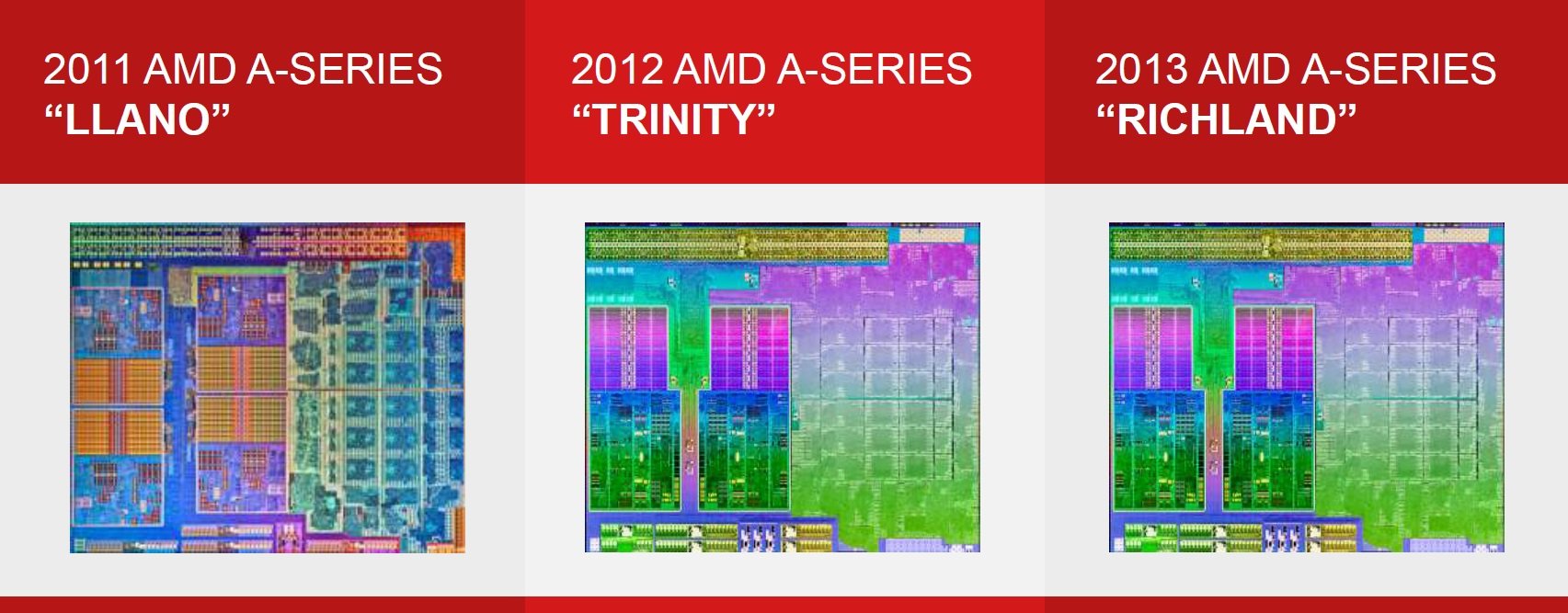
The semiconductor die being the same, we cannot expect the Richland to get faster by means of more x86 cores or shader processors. As before, the senior APU models are based on two Piledriver modules, so they have four execution cores. The maximum version of the graphics core only has 384 unified shader processors.
So why did they change the brand name on the Trinity series, especially as the latter was introduced less than a year ago? On the mobile market AMD makes up for the lack of hardware innovations by means of software tools. For mobile Richland-based APUs these include accelerated system startup, gesture control, face recognition, wireless connection of TV-sets, and driver-level real-time video processing. Increased battery life and certain performance improvements (thanks to higher clock rates and modified Turbo Core technology) top this up.
It would be pointless to provide this set of features with desktop Richland-based APUs, so AMD has limited itself to a small increase in performance and a more aggressive Turbo Core. Using more accurate APU die monitoring and flexible voltage and frequency control, AMD promises that its Richland-based APUs will stay up to 25% longer in the turbo mode than their predecessors.
As for default clock rates, the peak clock rate of the x86 cores is increased by 5-10% in the Richland compared to the Trinity. The graphics core has become 6-11% faster. The slow progress is due to the fact that the new Socket FM2 APUs have the same TDP as their predecessors: 65 and 100 watts.
For the desktop Richland APUs not to be too much alike to their Trinity predecessors, AMD talks about an improved memory controller. The company’s desktop APUs now officially support DDR3-2133 SDRAM, even though in the top-end model only.
Otherwise, the Richland is the same as the Trinity. And that’s not so bad after all since it is fully compatible with the existing Socket FM2 ecosystem. The Richland doesn’t call for new mainboards, working smoothly on platforms with old A85X, A75 and A55 chipsets after a BIOS update. Dual Graphics configurations are supported so the integrated graphics core of the new APUs can be combined in CrossFireX subsystems together with discrete graphics cards of AMD Radeon HD 6450, 6570 and 6670 series.
Model Lineup
A model range update like the Richland announcement would have gone unnoticed in the past. The increased clock rates would have only led to a quiet appearance of new products on price lists with slightly higher model numbers. But AMD wants to make some noise and play with its product names. There is a new codename, the old graphics core has got a new series number, and the new APUs belong to the new 6000 series.
The only problem is that the Richland-based APUs are not progressive enough to replace the Trinity series. They only add to it. The older products get mixed up with the new ones, so any correlation between performance and model number gets lost. Some 5000 series Trinity APUs may be faster and more functional than 6000 series Richland APUs, and the potential buyer can get utterly confused.
With the newly announced models, the full line-up of Socket FM2 APUs now looks like follows:
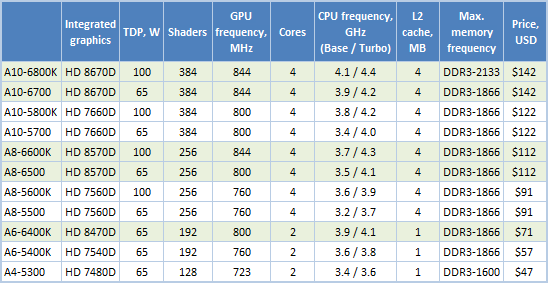
The model numbers and graphics core indexes do not reflect any technological improvements, so you can disregard them altogether. The only difference between the older and newer APUs is about their clock rates, and even this difference isn’t dramatic. The quad-core A10-6800K and A10-6700 are faster than the A10-5800K and A10-5700 by 5-7% (in terms of both x86 and graphics cores). The quad-core A8-6600K and A8-6500 are up to 10% faster than the A8-5600K and A8-5500. And the new dual-core A6-6400K is about 6-8% faster than the A6-5400 in terms of clock rates.
As before, the Richland APUs include a number of K series models which have an unlocked frequency multiplier. Take note that the senior overclocker-friendly APUs with four x86 cores, the A10-6800K and A8-6600K, have a TDP of 100 watts whereas the other Socket FM2 APUs are 35 watts more economical. On the other hand, the K series are 200 MHz faster. Considering that graphics performance is highly important for APUs, the A10-6700 looks an interesting model. It is quite economical. Its computing performance is comparable to the A10-5800K and its graphics core delivers the highest performance among all Socket FM2 products.
We’ve got the top-end 100-watt Richmond for our tests, though. The AMD A10-6800K is used by AMD to showcase the benefits of this CPU design, so it has as many x86 cores and shader processors as possible and all of its clock rates are at their maximums. Moreover, it is the only Socket FM2 processor to officially support DDR3-2133 SDRAM.
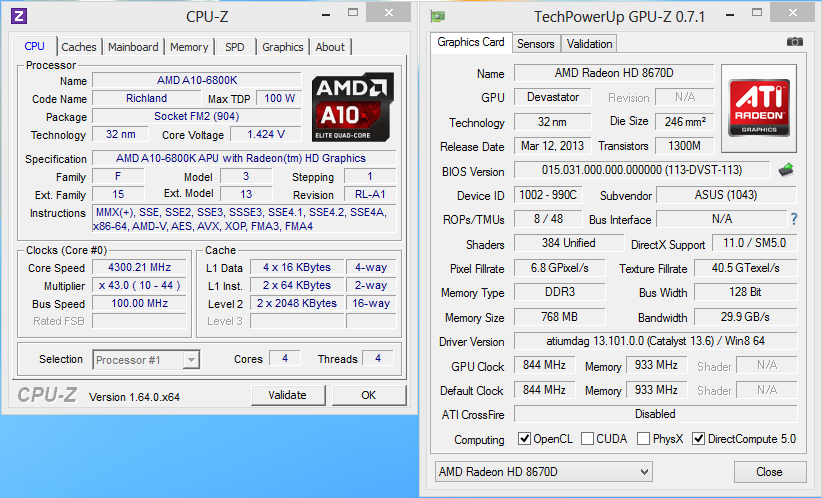
The specified frequency range of 4.1 to 4.4 GHz doesn’t give us any clue as to how the A10-6800K uses Turbo Core technology. The latter has actually become more aggressive than before, so the CPU spends most of its time working at 4.2-4.3 GHz. If not all of its cores are in use, the CPU can even be clocked at the maximum 4.4 GHz.
The Trinity used to drop its clock rate under continuous and high multithreaded load. The Richland does the same, its Turbo Core technology being able to lower the clock rate to 3.8 GHz in this case. It doesn’t do that often, though. The previous-generation APUs would do so with much higher probability.
The integrated graphics core has no automatic overclocking or power-saving features. It is always clocked at the specified 844 MHz.
Testbed Configuration and Testing Methodology
Since the Richland generation representative that we managed to get hold of for this test session, A10-6800K processor, is none other but a slightly improved previous flagship A10-5800K Socket FM2 processor, we decided to compare side by side these formally similar APUs, which, however, belong to different design generations. The competition from Intel will be represented by two LGA 1155 processors with comparable price tag: Core i3-3225 (a dual-core processor with Intel HD Graphics 4000 graphics core) and Core o5-3330 (the least expensive quad-core, which features a slower Intel HD Graphics 2500 graphics core inside, just like the majority of the desktop Ivy Bridge processors these days.
As far as Intel Haswell is concerned, there are currently no desktop offerings within that family, which could even remotely compare with Socket FM2 Richland desktop processor. Therefore, we are going to stay away from comparing our today’s hero against it.
As a result, we ended up using the following hardware and software components for our testbeds:
- Processors:
- AMD A10-6800K (Richland, 4 cores, 4.1-4.1 GHz, 4 MB L2, Radeon HD 8670D);
- AMD A10-5800K (Trinity, 4 cores, 3.8-4.2 GHz, 4 MB L2, Radeon HD 7660D);
- Intel Core i5-3330 (Ivy Bridge, 4 cores, 3.0-3.2 GHz, 6 MB L3, HD Graphics 2500);
- Intel Core i3-3225 (Ivy Bridge, 2 cores + HT, 3.2 GHz, 3 MB L3, HD Graphics 4000).
- Mainboards:
- ASUS P8Z77-V Deluxe (LGA1155, Intel Z77 Express);
- ASUS F2A85-V Pro (Socket FM2, AMD A85).
- Memory: 2 x 4 GB, DDR3-1866 SDRAM, 9-11-9-27 (Kingston KHX1866C9D3K2/8GX);
- Disk sub-system: Crucial m4 256 GB (CT256M4SSD2).
- Power supply unit: Corsair AX760i (80 Plus Platinum, 760 W).
- Operating system: Microsoft Windows 8 Enterprise x64.
- AMD Catalyst 13.6 Beta Driver;
- AMD Chipset Driver 13.4;
- Intel Chipset Driver 9.4.0.1017;
- Intel HD Graphics Driver 15.31.3.64.3071;
- Intel Management Engine Driver 9.5.0.1345;
- Intel Rapid Storage Technology 12.5.0.1066.
We used the following driver versions:
Taking into account eh APU concept, all benchmarks were performed without the discrete graphics. The graphics cores were fully responsible for displaying the image on the monitor.
Computing Performance
To estimate the average performance of our today’s testing participants we used a new Futuremark PCMark 8 benchmark. It uses three testing scenarios: Home, Work and Creative, and all three are part of our today’s test session. I would like to point out that Futuremark implemented a number of heterogeneous algorithms in their benchmarking utility, which can utilize the potential of the integrated graphics cores for calculations via OpenCL. We do not disable this feature deliberately during our test session.
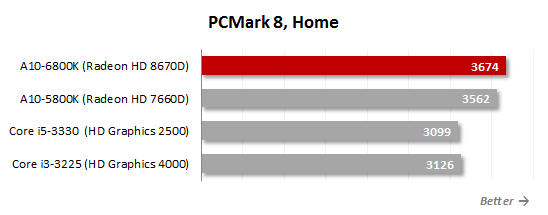
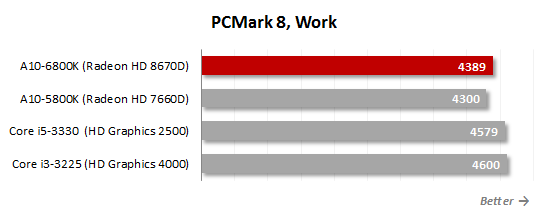
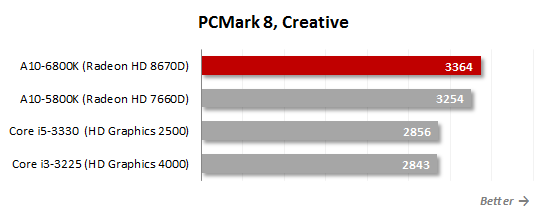
The next diagram shows one of the intermediate scores from Futuremark 3DMark Fire Strike benchmark – Physics Score. This score shows how fast the system can complete a special gaming physics test that emulates the behavior of a complex system with a large number of objects in it.
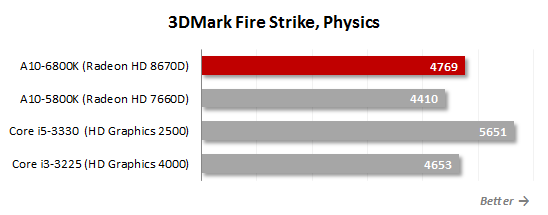
To test the platform performance in office tasks we resorted to a special test script from Futuremark that emulates the user’s typical action in Microsoft Word 2010, Microsoft Excel 2010 and Microsoft PowerPoint 2010.
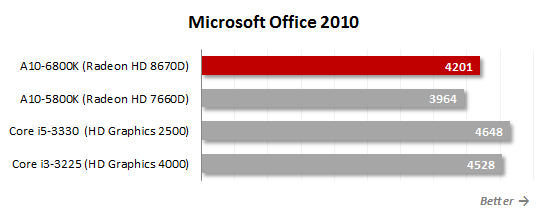
The performance in Internet applications was tested using Futuremark Peacekeeper browser benchmark that employs all latest resource-consuming web-technologies. We launched this benchmark in Google Chrome 27 browser.
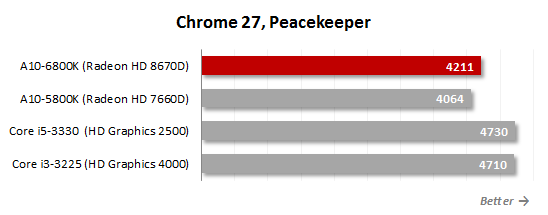
To test the processors performance during data archiving we resort to WinRAR 5.0 archiving utility. Using maximum compression rate we archive a folder with multiple files with 1.1 GB total size. The following chart shows the time it took to complete in seconds.
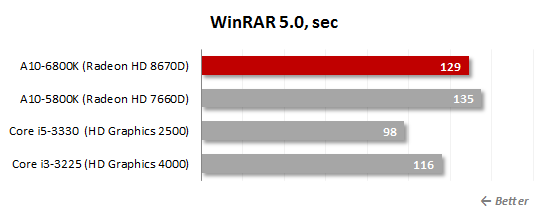
We use special Cinebench 11.5 benchmark to test final rendering speed in Maxon Cinema 4D engine from the professional suite.
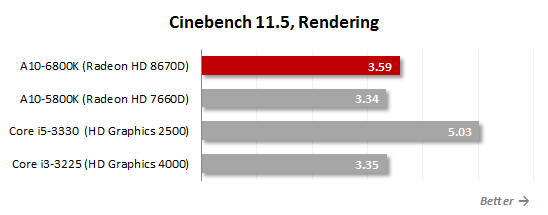
In order to measure how fast our testing participants can transcode a video into H.264 format we used x264 FHD Benchmark 1.0.1 (64 bit). It works with an original MPEG-4/AVC video recorded in 1920×1080@50fps resolution with 30 Mbps bitrate. I have to say that the results of this test are of great practical value, because the x264 codec is also part of numerous popular transcoding utilities, such as HandBrake, MeGUI, VirtualDub, etc.
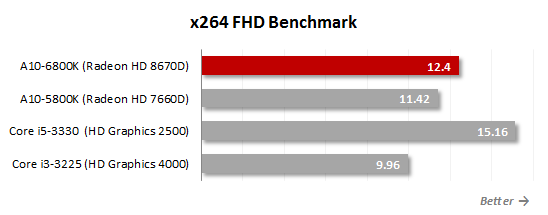
We benchmark CPUs in Adobe Photoshop CS6 using our custom test script. The results on the diagram represent the time it takes to complete this test in seconds.
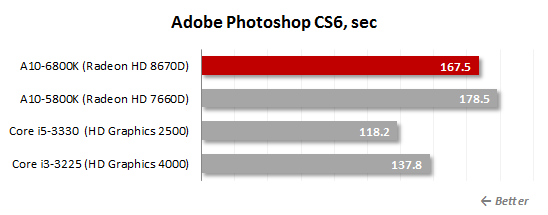
On average, all benchmarks that target general purpose performance of the processor cores, show that A10-6800K is only 5% faster than A10-5800K. It illustrates perfectly the fact that there are no microarhictectural improvements in the computing part of the APU. The performance improvement that we see in the new Socket FM2 APUs based on Richland design is directly connected with the increase in their clock frequency.
Overall, we can say the same thing about the performance of the new A10-6800K processors in traditional general-purpose applications as we said before. Piledriver microarchitecture is not very efficient with low-threaded processor load therefore, if the tasks do not generate numerous parallel processes, A10-6800K falls behind Core i3 and Core i5 from Ivy Bridge generation. AMD APU can only break this pattern in two completely different cases. It should either be in case of low-threaded load, where quad-core A10-6800K can outperform at least he dual-core Core i3-3225, or in applications where some of the calculations can be relayed to the graphics core. In this group of benchmarks it will be PCMark 8, therefore, Richland gets ahead of Core i3-3225 as well as Core i5-3330 in some of its testing scenarios.
Graphics 3D Performance
Gaming performance is estimated from the specialized synthetic Futuremark 3DMark Fire Strike benchmark as well as from the average fps readings in such real games as Metro: Last Light, F1 2012, Tomb Raider (2013), Hitman: Absolution and Battlefield 3. We used two testing mode: 1366×768 resolution with medium image quality and 1920×1080 resolution with maximum image quality settings. Note, that we also added the results for Core i7-4770K for your reference, which will allow us to get some preliminary idea of what the latest Intel HD Graphics 4600 core in Haswell processors is capable of.
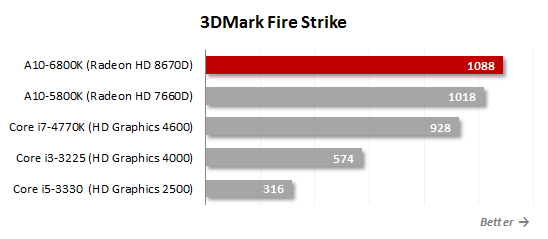
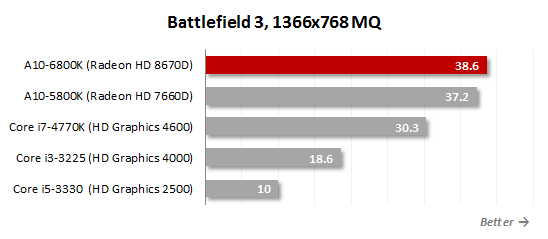
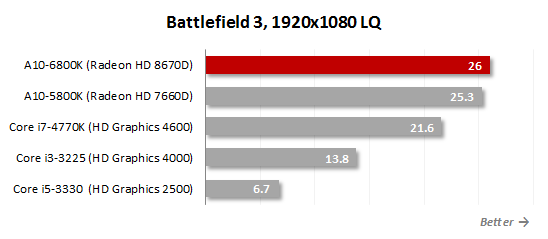
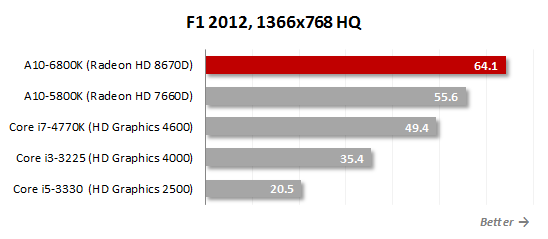
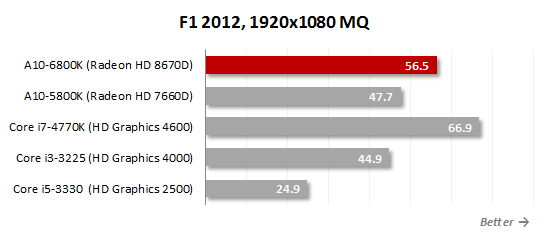
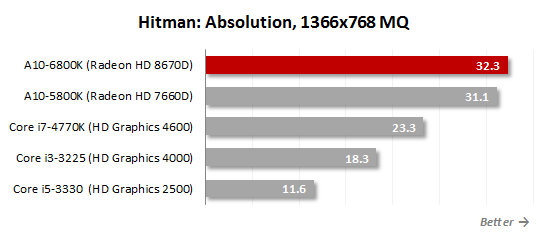
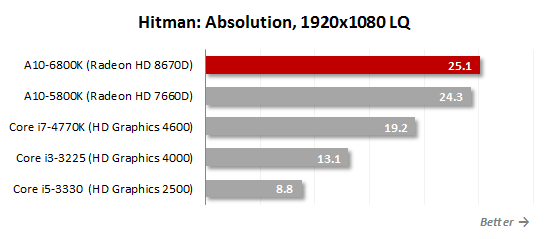
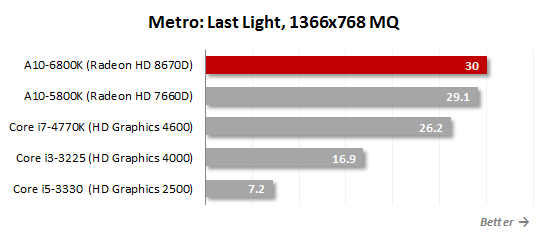
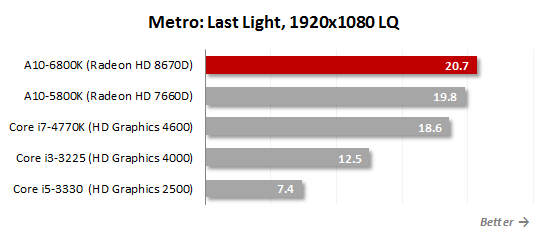
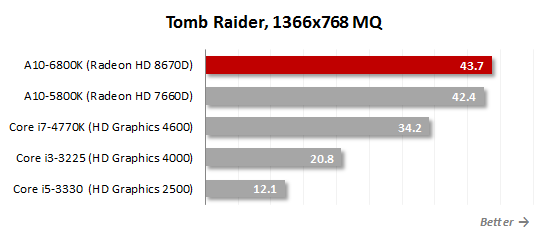
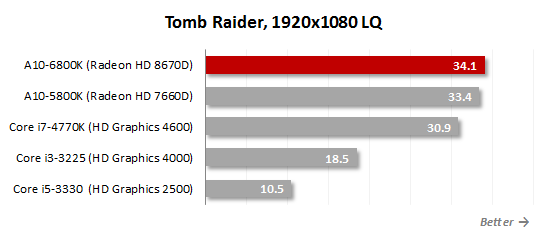
And again, no surprises here. The gaming performance increase in A10-6800K compared with A10-5800K is about 4-5%, which indicates that there are no architectural differences between the Trinity and Richland graphics cores. The performance improvement results solely from the increase in the graphics accelerator clock speed, which increased by 44 MHz in the new processor generation. In other words, nothing has actually changed in the gaming performance of the new Socket FM2 platform.
AMD claims that the performance of the Radeon HD 8670D graphics accelerator in A10-6800K processor is sufficient to run contemporary games in FullHD resolution. And in fact, I could agree with that. However, it is important to keep in mind that we are talking about low image quality settings and are accepting the fact that it will not always be the case. Some AAA-shooters, such as Metro: Last Light, for example, are way too much for AMD APU to handle and the launch of the new Richland design didn’t change that.
However, the integrated AMD graphics engine is anyway better than the competition. Graphics cores in Intel processors offered at a comparable price, such as Intel HD Graphics 2500 and Intel HD Graphics 4000, offer significantly lower 3D performance.
Heterogeneous Computing Performance
Promoting its hybrid processors, AMD keeps on reminding us that the integrated graphics core can be used to accelerate general-purpose computations. That’s true. The OpenCL and DirectCompute frameworks that enable parallel computing on both x86 and graphics cores are supported by both the AMD Trinity and the Intel Ivy Bridge series. And while they used to be used by very few specialized applications, the idea of heterogeneous computing has become much more widespread now. Today AMD already has a pretty impressive list of applications that get accelerated in the APU due to the graphics core potential.
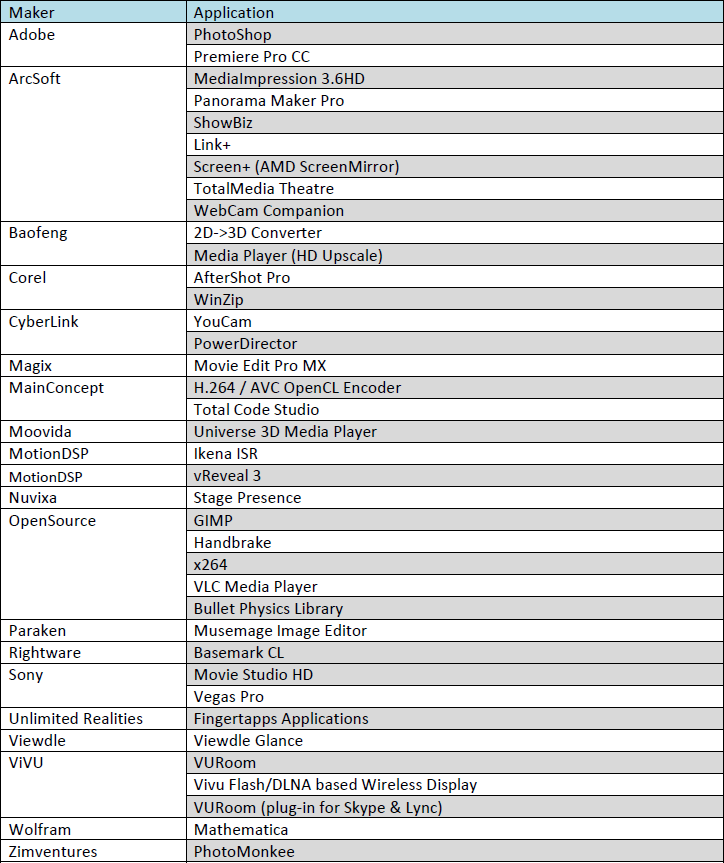
That’s why we would like to run some performance tests in applications that can make full use of all the versatile resources provided by hybrid processors.
We prefer to start with a special Basemark CL benchmark, which replicates typical tasks, which use OpenCL calculations, such as image processing or physics simulation with results visualization. Moreover, Basemark CL takes into account the arithmetic capacity of the OpenCL calculator unit.
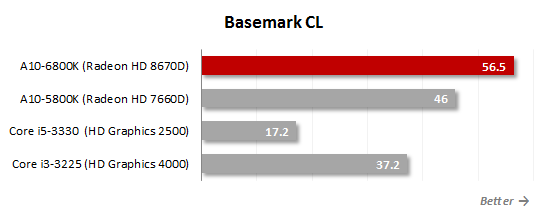
The advantage of the AMD APU is obvious and undisputed. At the same time Basemark CL reveals a significant increase in Richland performance compared with Trinity. Looks like the driver optimizations do the trick here.
The second OpenCL benchmark we used was SVPMark 3. It is a specialized performance benchmark for the SmoothVideo Project software which improves video playback smoothness by inserting new intermediary frames into the video stream. This software makes active use of GPU resources via OpenCL.
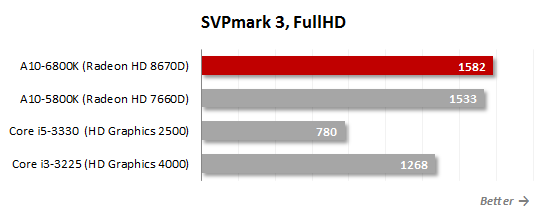
Here AMD A10-6800K is again considerably faster than Intel processors. However, the performance difference between them and their predecessors with Trinity design is truly insignificant and makes only 3%.
One of the greatest achievements in the APU concept that indicates its broad adoption by the software market is the introduction of OpenCL support in a popular WinZIP archiving utility. We used WinZIP 17.5 to compare the compression speed of 850 MB a folder with files into zipx format.
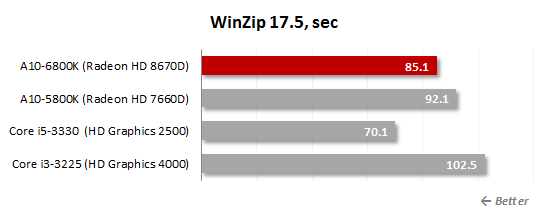
Calculations acceleration in OpenCL helps AMD processors to outperform Core i3-3225. However, both, Richland and Trinity products fail to beat the quad-core Core i5-3330. Note that the performance difference between A10-6800K and A10-5800K is about 8% in this case.
Another example of a popular OpenCL-compatible application is the professional video editing tool Sony Vegas Pro 12. When rendering video, it can distribute the load among all the computing resources of hybrid processors.
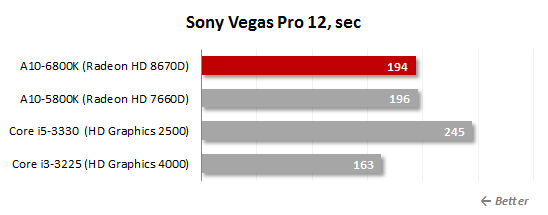
The performance differences between A10-6800K and A10-5800K are minimal, but there is another remarkable fact here: Core i3-3225 with Intel HD Graphics 4000 graphics core offers better performance here than AMD APUs.
The other popular video processing task is transcoding. Today, every graphics core developer has realized that specialized transcoders should be integrated into their solutions. We checked out the transcoding capabilities of the tested processors using CyberLink MediaEspresso 6.7 that supports both Intel Quick Sync and AMD VCE. During this test, a 1.5GB 1080p H.264 video clip (a 20-minute episode of a TV series) was transcoded into a lower-resolution format for viewing on an iPhone 4S (H.264, 1280×768 pixels, about 6 Mbps bitrate).
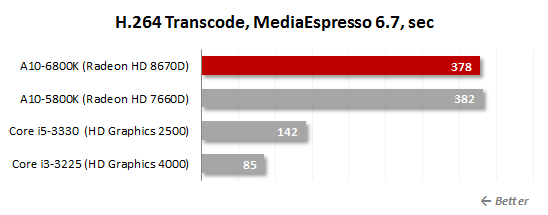
It is very difficult to compete against Intel Quick Sync in video transcoding speed. Intel’s transcoding implementation uses a highly efficient combination of specialized hardware units and has some of the tasks processed using graphics core resources. AMD solution merely relays the calculations to parallel stream processors, which generates certain bottlenecks taking into account the transcoding algorithm specifics. As a result, even the junior Intel HD Graphics core model 2500 offers 2.5 times faster transcoding speeds than A10-6800K. As for the Richland design, as we can see, it didn’t produce almost any gain compared with Trinity.
Power Consumption
The performance of the hybrid Richland processors increased due to slightly higher clock frequencies. However, there are no changes to the architecture or manufacturing process, which makes us a little concerned that their power consumption may possibly increase, too. Since Trinity couldn’t boast very good power consumption levels, it would be highly undesirable.
To find out more about the power consumption of the new AMD A10-6800K APU, we performed a round of special tests. The new digital power supply unit from Corsair – AX760i – allows monitoring consumed and produced electrical power, which we use actively during our power consumption tests. The graphs below (unless specified otherwise) show the full power draw of the computer (without the monitor) measured after the power supply. It is the total power consumption of all the system components. The PSU’s efficiency is not taken into account. The CPUs are loaded by running the 64-bit version of LinX 0.6.4 utility. We used FurMark 1.10.6 utility to load the graphics cores. Moreover, we enabled Turbo mode and all power-saving technologies to correctly measure computer’s power draw in idle mode: C1E, C6, Enhanced Intel SpeedStep and AMD Cool’n’Quiet.
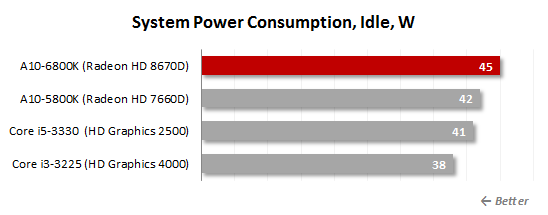
In idle mode AMD A10-6800K based system consumed a few watts more power than the same exact platform with A10-5800K inside. This can be explained by the fact that for some reason Richland’s minimum frequency in idle mode was set at 2.0 GHz, while Trinity processors lowered it more: to 1.4 GHz.
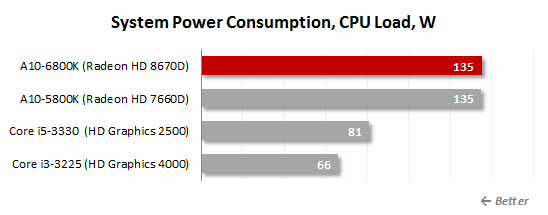
In case of full general-purpose load on the Piledriver cores, the power consumption readings of AMD A10-6800K and A10-5800K level out. It means that Richland’s acceleration didn’t come at the expense of higher power consumption and higher heat dissipation, and the declared TDP for difference generations of Socket FM2 processors does in fact reflect the real state of things. Note that AMD A10-6800K consumes much more power than Intel CPUs, which is actually quite logical, because the calculated TDP of the Core i3 and Core i5 processors from Ivy Bridge generation is set at 55 W or 77 W instead of 100 W by A10-6800K.
Under heavy graphics load AMD A10-6800K and AMD A10-5800K based systems also consume about the same amount of power, with a slight advantage in Trinity’s favor. Core i3 and Core i5 need significantly less power in this case, but it is important to remember that they also have much lower 3D performance.
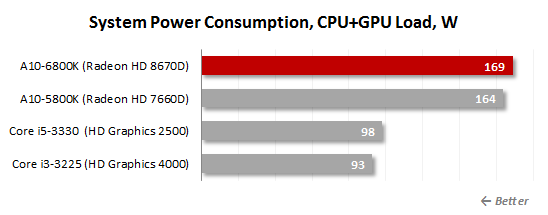
Full utilization of all types of cores in hybrid processors reveals that Richland is still a somewhat more energy-hungry design than Trinity. In fact, everything is within reason. The difference we observe is only 5 W. Intel processors, however, again demonstrate slightly better power consumption than their Socket FM2 competitors. However, we wouldn’t draw any preliminary conclusions at this point, until we get our hands on a better Richland processor with a 65 W TDP.
Overclocking
The Trinity series wasn’t much into overclocking. Of course, like the new Richmond series, it included special K-indexed models with unlocked frequency multipliers, but the Piledriver cores don’t have much untapped frequency potential because Piledriver-based APUs are clocked at frequencies higher than 4 GHz even at their default settings. And the Richland APUs have even higher clock rate without any changes in manufacturing process or semiconductor design. That’s why the A10-6800K didn’t overclock much. The peak frequency for our sample was 4.8 MHz, i.e. a mere 400 MHz higher than its Turbo frequency. The voltage had been increased to 1.5 volts and we cooled the APU with an air cooler NZXT Havik 140.
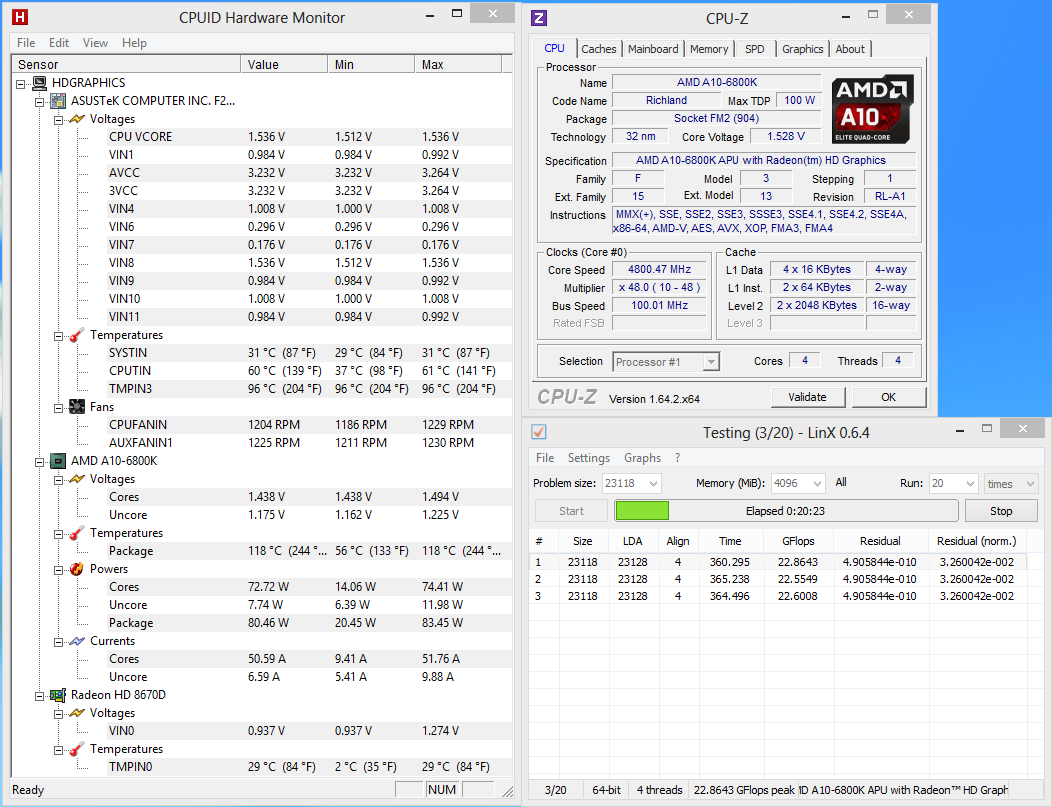
The result shouldn’t be underestimated, though. In fact, the Richmond series, as represented by the A10-6800K, is friendlier towards overclockers than its predecessor. We couldn’t reach such clock rates in our tests of the A10-5800K with the same cooling.
Besides, the screenshot shows that the manufacturer has finally managed to make the internal thermal sensor work more or less correctly. It now reports a true-to-life value for the APU die temperature. By the way, the peak permissible temperature for the A10-6800K is 120°C, so our overclocking was limited by the cooler’s performance. As opposed to the Haswell, the temperature of the A10-6800K correlates directly with its heat dissipation, so replacing the cooler with a higher-performance one would have helped us reach higher clock rates.
The remaining 42% of the APU can be overclocked, too. We mean the graphics core. After setting its voltage at 1.425 volts, we made the integrated Radeon HD 8670D work at 1169 MHz, or 325 MHz higher than the default clock rate. We lowered the frequency of the APU’s x86 part to 4.7 GHz in this case to guarantee stability under mixed loads.
As the last step in overclocking our hybrid platform we selected the highest system memory frequency. The Richland’s controller supports DDR3-2400 and we had no problems enabling that clock rate. As a result, we had a well-overclocked platform whose graphics performance was much higher than at the default settings.
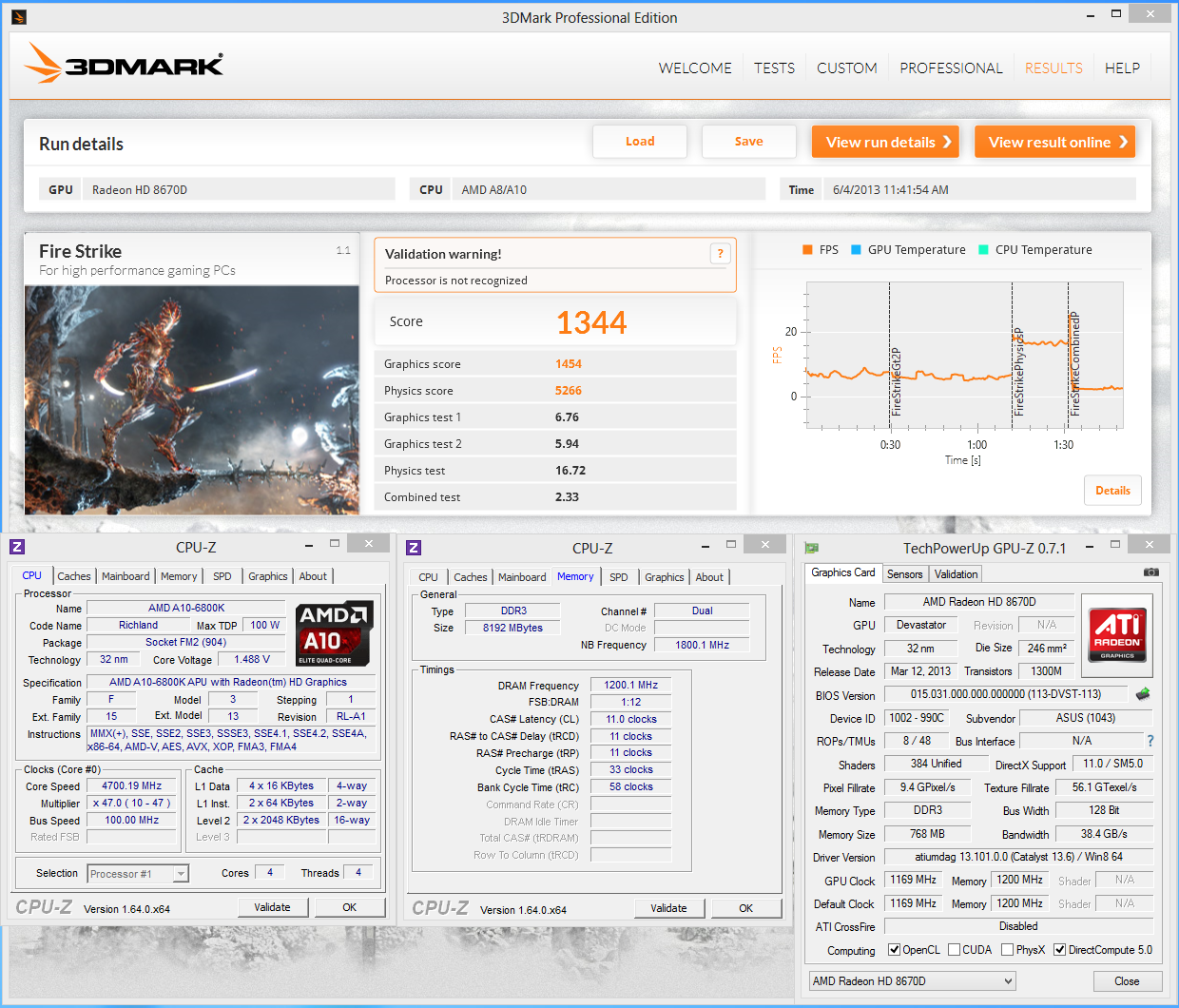
The overall score of the overclocked A10-6800K is almost 25% higher, its x86 part having accelerated by 10% according to the gaming physics test. The integrated Radeon HD 8670D is comparable to Radeon HD 6670 graphics cards when overclocked.
Conclusion
No resolution took place. New desktop hybrid processors, which were previously known as Richland and now belong to the new 6000-series brought only minimal changes to the Socket FM2 platform. AMD tried really hard to turn Richland into a new hit, but if we put aside all the marketing wrappers, then we will see the same Trinity processors with slightly increased clock speeds and nothing else. However, even these few little moment of joy that the new A10-6800K gave us today are quite adequate. It is great to have slightly better computing and graphics performance at the same heat dissipation and power consumption levels as well as to experience improved overclocking results.
Overall, Socket FM2 platform has always made a very positive impression right from the start, especially when it came to graphics or heterogeneous performance of the top models in the line-up. AMD developers have combined all their best efforts to give us Trinity and managed to roll out a few very attractive solutions based on it later on, especially in terms of pricing. Even though the improvement in Richland is small, it is nevertheless and undeniable step forward, which will allow AMD to maintain interest to their Socket FM2 platform at least until their principally new heterogeneous Kaveri processors are ready to roll.
Therefore, we will continue to recommend AMD A10 series processors as great products for office as well as inexpensive home gaming or entertainment PCs. Of course, it is important to mention that the graphics in Trinity and Richland processors is integrated and doesn’t support all games out there in FullHD resolution even with minimal image quality settings. But a lot of contemporary games will run on integrated AMD A10 graphics at a sufficient fps rate, while Intel cannot currently offer even that. At least, not until Haswell microarchitecture makes its way into the sub-$150 processor models.